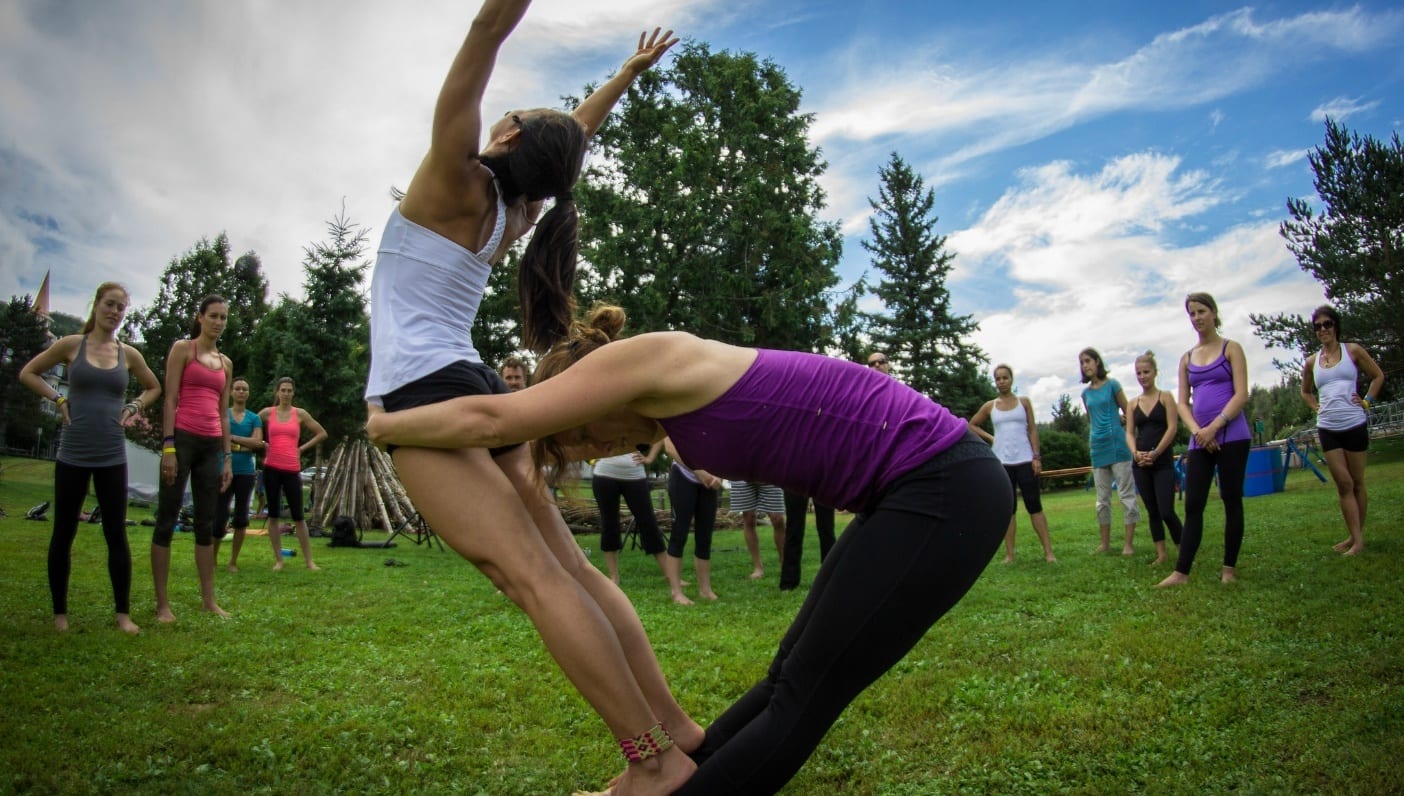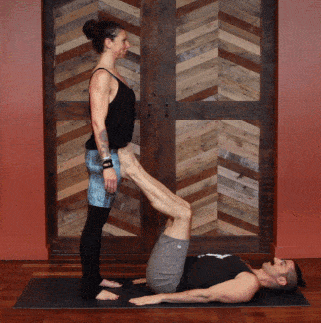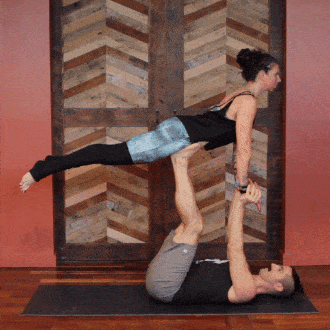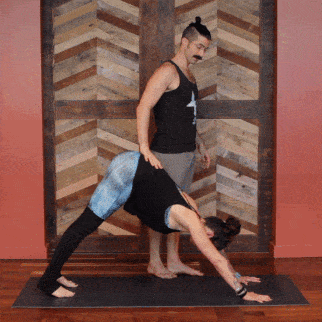
Learning to move with and be moved by someone else is an amazing experience, and much easier than you think. There’s more to partner yoga than just pretty shapes and flashy Instagram posts. Don’t worry about how it looks—bring awareness to how it feels.
In this series, Daniel Scott—yogi provocateur and ambassador of trust—offers valuable insight on how to best share your movement practice with ease, accessibility, and fun. Want to try Acro? Daniel and his fiance and acro partner Lauren Matters are teaching at both Wanderlust Stratton and Wanderlust Whistler this year.
Ready to fly? It’s easier than you think. The following progressions offer clear, accessible, and intuitive exercises designed to help you master one of the most important AcroYoga poses: Bird (aka Front Plank). By focusing on technique instead of strength, you’ll tap into the power of proper alignment to build trust and move bodies. All you need is a partner (obviously), a little bit of patience, and a willingness to trust. You’ve got this!
Exercise 1: Standing Plank Presses
First things first: Muscles tires, bones do not. Learn to support your partner’s weight with extended arms, and then work on moving their body with proper alignment. Refresh your memory with a quick review of proper grip in my earlier article on bonestacking before jumping into this fun exercise to ensure everyone keeps their wrists happy!
Have one partner standing, the other kneeling on one knee. Find the same grip from STANDING PLANK, and work on finding ease in shared balance through extended arms. Once comfortable, the kneeling partner can work on slowly drawing their elbows in towards their rubs chaturanga-style, keeping wrists in line with their elbows and the standing partner’s shoulders. Rock a few presses, and then have the standing partner work on doing a few chaturangas on the kneeling partner’s arms.
Exercise 2: Reclined Plank Presses
Many people see this and think it’s easy—only to flop each other around and abuse trust like it’s going out of style. Do yourselves a favor and avoid the rookie mistake of approaching this shared movement like leg day at the gym. (See the „Stick-in-the-Mud“ exercise in this article for more information.)
Find that perfect fit. BASE, you want to feel your Flyer’s hip bone just below your big toe joint. FLYER, make sure your Base’s heel is stepping into your thigh bone. BASE, don’t be afraid to use your toes. FLYER, hold that shape by lifting your chin and chest and climbing your hips into your Base’s feet. Remember: This is not about the Base leading and the Flyer following—work on moving together!

Exercise 3: Reclined Plank Press to Hands
Work on passing the connection from feet-on-hips to hand-in-hands. Note how the Base keeps the arms extended while the Flyer gazes forward the whole time, creating a full line from the Base’s shoulders to the Flyer’s through the hand connection.
Can you see the triangles? That is some fine Acro-Architecture!
HINT: Check the Flyer’s feet, the Base’s shoulders, and the connection point (hands, feet, hips).

Exercise 4: Chaturanga Lean
Next, the Flyer can work on rocking a slow and controlled chaturanga, lowering his or her chest/ribs towards the hands. Note how she keeps her elbow stacked in line with her wrists and the Base’s extended line from his shoulders. Remember: Flyers, save those wrists and pour weight through the base of your wrists instead of pushing into your Base’s fingers and knuckles.

Exercise 4: Stack Check
Once you’ve got your upper bodies connected, let’s focus on the Base’s legs for a bit. BASE, lift your ankles up above your hips. Can’t fully extend your legs because of tight hips and/or hamstrings? Tailbone and sacrum don’t quite rest on the ground? No problem—fold a towel or blanket up and pad your hips. This will help considerably as you try to find bonestacking here.
Note the line between the hips and the ankles: BASES don’t have to lock out or fully extend their knees. We’re gifted with a lot of meat to support the bones in our lower body. Check how I’m gently testing the angle for my Base here—moving the hip/ankle stack past 90 degrees in both directions and adding a little downward weight. BASES, what do you feel when that happens? (Easy when stacked; pressure in the core when the legs are closer to your face; pressure in the lower back when the legs lean away.) Keep this in mind!
Exercise 5: Bird Mount
Step 1: Reclined Press to Hands (keep feet on hips)
Step 2: Chaturanga Press (FLYER folds hips to lower shoulders to hands, BASE bends knees in to stack Flyer’s hip over theirs)
Step 3: BASE extends legs, FLYER gently lifts heels
Step 4: YAAASSSSSSSSSSSSS!
Step 5: Bring it back down and repeat, like, a billion times.
Pro-tips: BASE, Keep arms stacked above shoulders, not past head. FLYER, Maintain a forward gaze and for goodness sakes—don’t hop up. Nobody pulls, everybody pours. Flyers give (weight) in, Bases give (weight) up. See how the Base taps the Flyer’s feet just before beginning? Just do it.

Exercise 6: Point and Flex (*Advanced Variation*)
This one is pretty straightforward: Flyers work on holding the line while keeping weight in the hands, Bases build ankle flexibility and leg strength. Use this exercise to make mounting and dismounting as smooth as silk!
BASE points ankles and toes? FLYER’s shoulders raise.
BASE flexes ankles? FLYER’s shoulders lower.
As long as BASE keeps extended arms, FLYER can work on those chaturanga presses to maintain control.

Exercise 7: Bird Presses (*Advanced Variation*)
Pro-Tips: BASES, arms extended and stacked. FLYERS, chaturanga press to keep some weight in the hands.

Exercise 8: Free Bird / Bow (*Advanced Variation*)
Obligatory Dirty Dancing reference.
Pro-Tips: BASES, strong toes! Use your ankle point to help Flyer removed weight from their hands. FLYERS, rock a strong shalabasana (locust pose). Slowly sweep your hands back towards your hips to maintain balance. It’s important that you don’t rip the hands away from each other! This isn’t a game of chance.

—
 Daniel Scott is yogi provocateur offering a fresh alternative to the traditional “yoga voice”. His classes are a lively mix of balance and improv, strength and flexibility, breath and body. With light heart and open mind, Daniel focuses on moving into postures, not through them. A globally renowned ashtanga-vinyasa teacher and Certified Level 2 AcroYoga instructor, Daniel enjoys barefoot running, street art, good coffee, large quantities, and great qualities. Deeply dedicated to sharing in the immense journey from self-conscious to self-aware, Daniel Scott strives to answer the ever-present question: Are you moving or being moved?
Daniel Scott is yogi provocateur offering a fresh alternative to the traditional “yoga voice”. His classes are a lively mix of balance and improv, strength and flexibility, breath and body. With light heart and open mind, Daniel focuses on moving into postures, not through them. A globally renowned ashtanga-vinyasa teacher and Certified Level 2 AcroYoga instructor, Daniel enjoys barefoot running, street art, good coffee, large quantities, and great qualities. Deeply dedicated to sharing in the immense journey from self-conscious to self-aware, Daniel Scott strives to answer the ever-present question: Are you moving or being moved?